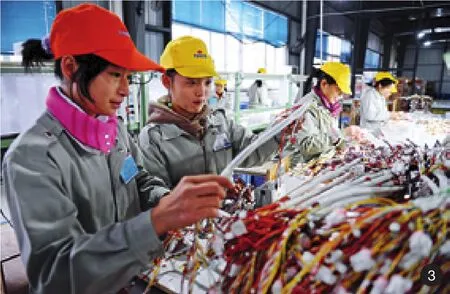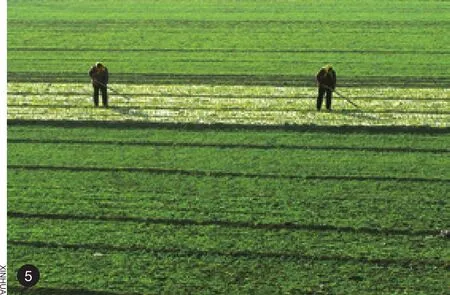SUCCESS OUTSIDE THE CITY
Coming as a much-needed boon for the countryside, this year’s No.1 Document, jointly released by the Central Committee of the Communist Party of China and the State Council, pledges a series of concrete measures to propel improvements in the rural economy and the livelihood of farmers. Nevertheless, rural prosperity in line with the success of urban areas will prove to be a challenge. The foundation of the agriculture sector remains fl uid, and farmers lack a stable source of income and a reliable social safety net.So how can China promote the sustained development of its agriculture sector and social improvements to the countryside? Experts and economists provide suggestions to achieving these goals.
Forging rural prosperity
Chen Xiwen (Director of the Office of the Central Rural WorK Leading Group)
This year’s No.1 Document will have farreaching implications for the countryside and the national economy. This was the seventh time the central leadership dedicated the first document of the year to an agriculture-related issue. It vows vigorous efforts to improve the income for farmers and rural infrastructure,press ahead with modern agriculture and technological innovations, as well as raise grain yields and quality.
Coming off a rock bottom in early 2009,China’s rural economy has shown signi fi cant resilience, with grain output holding up and numerous unemployed migrant workers regaining their jobs. Nevertheless, a number of uncertainties still lie ahead for the sector to fully prosper. After years of torrid growth, the agriculture sector has come under increasing pressure from shrinking farmland and poor weather conditions. In addition, the country has felt the budget stresses of pumping money into rural businesses.
There are four highlights in the document that hold the key to rural development this year.
First, the country aims to boost farmers’incomes and bridge the expanding rural-urban divide. To achieve this, the policymakers will strengthen state purchases of corn,soybean and oil seeds, and support rural businesses with easier access to credit and other social resources.
Second, more efforts will be made to stimulate demands from rural markets, such as providing cash subsidies for home appliance, automobile and agricultural equipment purchases.
Third, the government has recognized the urgent need to push for an energy-efficient and innovative modern agriculture as the country reorients itself toward healthier growth. The country, for example, consumed a staggering 50 million tons of fertilizers in 2009, most of which was made from coal and natural gas.
Fourth, China is gearing up to hasten the integration of rural and urban areas and remove system barriers that are weighing down the prospects of the rural economy.
Around 60 percent of China’s 150 million migrant workers were born in the 1980s or 1990s, referred to as the “new generation of migrant workers” in the document, and are less acquainted with farming and wish to settle in cities. It is therefore necessary for policymakers to help integrate them into urban life and give them equal rights as urban residents.

1. HOUSING EFFORTS: Yuqing County in Guizhou Province has taken vigorous efforts to construct new houses in the countryside for farmers

2. FREE EDUCATION: Starting in 2010, children of migrant workers in Yuli County, Xinjiang Uygur Autonomous Region, receive free compulsory education in public schools

3. SUPPORTING EMPLOYMENT: Laid-off migrant workers from Shangyou County of Jiangxi Province get re-employed at a local business. The province has made stiff efforts to help with employing laid-off migrant workers, including providing vocational training and tax breaks for those starting their own businesses

4. WELFARE IMPROVEMENT: Yang Guochun (left), a farmer in Yanhe Village of Zunyi County, southwest Guizhou Province, and his fellow villagers over 60 years old have started receiving pensions since the beginning of this year

5. GREEN COUNTRY: Farmers in Heze County, Shandong Province, sow seeds in the warm and rainy spring this year
Statistics for Agriculture, Farmers And the Rural Area in China
The agricultural output value in 2009 stood at 3.54 trillion yuan ($519.6 billion),representing an increase of 4.2 percent year on year.
Grain output in 2009 was 530 million tons,0.4 percent higher than one year earlier.
Rural investments in fixed-assets grew 27.5 percent to reach 3.07 trillion yuan($449.7 billion) in 2009, 6 percentage points higher than one year earlier.
Per-capita annual net income for farmers reached 5,153 yuan ($755) in 2009,recording a growth rate of 8.5 percent year on year.
In November 2009, employed migrant workers numbered 152 million, higher than the level before the financial crisis.
(Source: National Bureau of Statistics)
Modern agriculture benefits China
Tang Renjian (Deputy Director of the Office of the Central Rural Work Leading Group)
The No.1 Document has sent out a strong signal that the country is increasingly looking to the rural markets as a sustainable source of growth.
China has no reason not to put the focus on the vast countryside where the enormous population and rising incomes present the potential for a consumption boom. Most importantly, a stable and vibrant agriculture sector could lay a solid foundation for an economic take-off and help cool down simmering in fl ationary fears.
Agriculture in China has shrugged off the ripple effect of the fi nancial crisis and picked up steam. But it is obvious that the outdated traditional agricultural production methods,which forced the country to rely heavily on imports of soybeans and cooking oil products, cannot keep up with rising demands.
A viable solution is to forge ahead with the aspects of modern agriculture that enjoy higher grain yields and energy efficiency.This would require heavy government support for agricultural talent, advanced technologies and capital.
To ease the fi nancial distress facing the rural economy, the document aimed at strengthening fi nancial services in rural areas, including small credit, village banks and insurance, and requires the Agricultural Bank of China and other policy banks to extend long- and medium-term loans for rural infrastructure projects.
The overall goal is to make banking services available in all villages and townships across China in the next three years, according to the document.
Fostering rural entrepreneurs
Zheng Fengtian (Deputy Director of the School of Agricultural Economics and Rural Development at Renmin University of China)
An overwhelmingly positive aspect of the No.1 Document is the encouragement and help the country gives farmers to start up their own businesses and improve the frigid employment landscape in the countryside.This is expected to stimulate the depressed job markets in the countryside and inject momentum into the rural economy.
As their wage growth stagnated in recent years, many migrant workers started their own businesses in rural areas as opposed to big cities where the costs of labor and land are increasing.
But after years of research, we are surprised to fi nd that the business environment in rural China is getting worse than it was in the 1980s, despite seemingly rapid economic growth. More disturbing, though, is the fact that the trend has shown few signs of easing.
Local governments tend to offer a variety of policy incentives to attract foreign investors,but when it comes to local rural entrepreneurs,they are much less enthusiastic. Stringent requirements in land use, tax rates and environmental protection have been the biggest bottlenecks, not to mention a lack of fi nancing.
On top of the dif fi culties came the fi nancial crisis that led to the closure of numerous factories in China’s eastern coastal provinces,sending millions of migrant workers back home. This only increased the dif fi culties farmers faced in starting up their own businesses.
In response, the authorities are supposed to guarantee the smooth implementation of the document and step up stronger policy incentives, such as business trainings and tax waivers for farmers. Efforts should also be enhanced to help with technological advancement of smaller rural enterprises and sharpen their competitive edge.
Farmers’ income is key
Han Jun (Director of the Research Department of Rural Economy of the Development Research Center under the State Council and one of the compilers of the No.1 Document for 2010)
By pledging to prop up rural development, the No. 1 Document has indicated a bright prospect for the rural economy.Among the many measures included in the document, one stands out∶ improving the income and other social bene fi ts for farmers.
Per-capita net income of farmers has increased more than 6 percent for five straight years, but is still well below that of gross domestic product. This has evidently weighed down the purchasing power of farmers and cast an ominous shadow over the rural consumer market.
However, boosting farmers’ wealth is easier said than done. The country’s annual grain output has exceeded 500 million tons for years, which has kept grain prices at dismal levels. Besides this, the earnings growth of migrant workers has lagged far behind that of urban residents.
But the good news is that faster wage growth for migrant workers may be on the way, as the labor surplus of the country seems to be running low. Late last year, many exporters in coastal areas even experienced acute labor shortages as they geared up to fi ll rebounding orders in the run-up to Christmas.It is an inevitable trend that employers will have to pay more for skilled migrant workers.
For the government, it is necessary to distribute heavier subsidies for farming and at the same time streamline the compensation systems for migrant workers and protect their deserved rights and bene fi ts. It would also be helpful to reinforce their vocational training and increase the value of rural labor.
Buoying rural demands
Zhang Xiaoshan (Director of the Rural Development Institute under the Chinese Academy of Social Sciences)
As China accelerates the shift to rely more on domestic demands, the rural market de fi nitely presents a rich bonanza of consumers, though it will take some time to explore its full potential.
The No. 1 Document for 2010 has mandated subsidies for rural purchases of construction materials, a measure widely considered a powerful catalyst for farmers to bump up spending.It will also encourage them to build better houses and improve their livelihoods.
Since early 2009, the government has distributed subsidies, allowing farmers to purchase appliances and vehicles. The document said the program would be continued and widened to cover employees of stateowned farms and forestry fi rms.
Many migrant workers have returned to the countryside, bringing back urban consumption habits. This will surely pump some steam into the rural consumer market and help widen domestic demands.
But subsidies are still far from enough,and China still has a long way to go to drive up rural consumption. In 2006, consumption by Chinese farmers contributed 5.8 percent to the rural economy, compared with 34.3 percent of urban households.
As a result, the country should double its efforts to increase the income of farmers and offer them more job opportunities. Efforts are also needed to further perfect the social security net, including medical insurance,education and pensions, to add incentives for them to spend.
China has every reason to continuously spark buying interest of farmers, the country’s largest group of potential consumers. A thriving rural consumer market would effectively wean the country off its dependence on exports and investments, and also absorb the industrial overcapacity, a serious conundrum for the Chinese economy. ■

